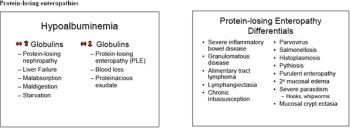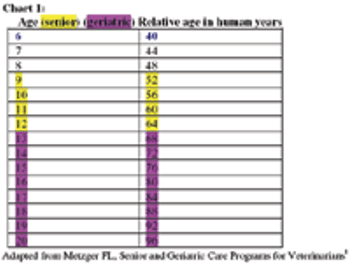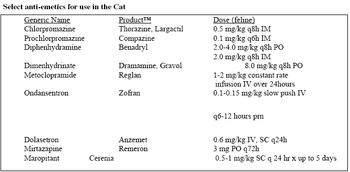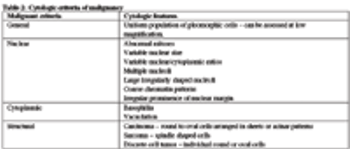
Bethesda, Md. -- Scientists at the National Human Genome Research Institute (NHGRI), part of the National Institutes of Health, say they have unlocked the key to the differences in dogs? coats.

Bethesda, Md. -- Scientists at the National Human Genome Research Institute (NHGRI), part of the National Institutes of Health, say they have unlocked the key to the differences in dogs? coats.

Dr. Darryl Millis, DVM, Dipl. ACVS, CCRP answers questions about the growth of rehabilitation therapy, common conditions encountered and how they are treated, advice to veterinarians and owners and his views on where the field is going.

From a pain practitioner's standpoint, it's much better for a practice to provide more service to existing clients than try to compete for new ones when patients die before their time. That was one of two key take-home points Robert M. Stein, DVM, Dipl. AAPM, pain specialist and president of the International Veterinary Academy of Pain Management (IVAPM), offered CVC Kansas City attendees Sunday morning during his presentation, "A day in the life of a pain practitioner," part of the IVAPM Symposium at CVC Kansas City. Stein practices in suburban Buffalo, N.Y.

Harrisburg, Pa. -- Gov. Edward Rendell yesterday signed into law a measure permitting only veterinarians to perform ear cropping and tail docking of dogs at least 5 days old, plus devocalization procedures, cesarean deliveries and declawing of cats at least 5 days old. The new anti-cruelty law is an amendment to HB 2525, enacted last October, that established space and facility requirements for cages, exercise and mandatory semi-annual veterinary examinations for dogs housed in commercial breeding kennels. It also outlawed the euthanization of dogs by anyone other than a veterinarian. The law and the new amendment were sponsored by State Rep. Thomas Caltagirone in response to a publicized case of two brothers who killed 80 dogs at their breeding facility instead of making improvements ordered by a state health inspector.

Calgary, Alberta -- Fleas are as susceptible now to the insecticide imidacloprid as they were in 2001, according to data presented last week at an international veterinary parasitology conference in Canada.

British Columbia -- Dogs' mental abilities are equivalent to a 2- or 2.5-year-old child, according to psychologist and canine researcher Stanley Coren, PhD, of the University of British Columbia.

Read a Q&A about canine influenza with Dr. Cynda Crawford.

Frankin, Tenn.

St. Paul, Minn. -- An experimental procedure to treat a dog with brain cancer that remains successful a year later has earned the University of Minnesota College of Veterinary Medicine funding to treat more dogs through clinical trials.

The USDA has filed an injunction against Teva Animal Health Inc. leaders.

Manhattan, Kan. -- A veterinary professor and fellow researchers at Kansas State University's College of Veterinary Medicine are conducting studies into the characteristics of the pandemic H1N1 flu virus and developing better detection methods.

The transfusion of blood products to treat acute blood losses, coagulopathies, and severe anemia has become indispensable in the care of critically ill veterinary patients.

Although the combination of hypoalbuminemia and hypoglobulinemia is "textbook" for a protein-losing enteropathy (PLE), it should be noted that a normal, or even elevated globulin level should never be the only reason to take PLE off a list of differentials that was generated by a history and physical examination.

Life expectancy for cats has risen, on average, to 14-16 years of age.

Before considering pathologic cytology of lymph nodes, it is necessary to define normal lymph node cytology.

Disorders of the esophagus include inflammation (esophagitis), neuromuscular dysfunction (megaesophagus, dysautonomia), anatomical abnormalities (stricture, herniation), obstruction (foreign bodies, vascular ring anomalies, extraluminal masses), and neoplasia.

In veterinary medicine, cats are too often treated as strange small breed dogs. To those who work with cats every day, the fallacy of this supposition is obvious.

Obese female cats are at greatest risk of developing hepatic lipidosis.

The normal physiologic and pathologic vaginal conditions.

Vomiting is among the most common reasons that dogs and cats are presented for evaluation.

Diarrhea is one of the most common presenting complaints in feline medicine.

Transfusion of blood products is a frequent necessity in small animal practice.

Blood gas analysis provides information about respiratory function and acid/base status.

Hemograms consist of both quantitative data (total cell counts, differential cell counts, red cell indices, etc.) and qualitative data (blood film morphology). Proper interpretation depends on the integration of both.

Accumulations of excessive fluid in the pleural, peritoneal, or pericardial space represent edema of these body cavities.

Many things can impact litter size in the bitch.

Successful management of the critically ill patient requires anticipation-not reaction.

It is important that the clinician formulate a treatment protocol based on a correlation of clinical course, laboratory and gross findings, and histologic findings rather than relying on histologic changes alone.

In the last ten years, exfoliative cytology has been gaining popularity as a diagnostic aid in veterinary practice.

Gastric dilatation and volvulus (GDV) is an acute, life-threatening condition which requires immediate medical and surgical intervention.